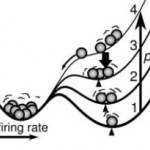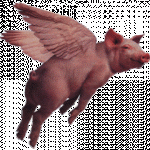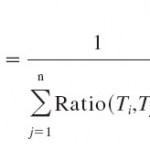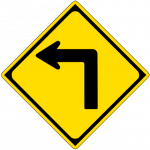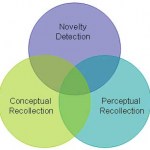
There are three on-off light switches on the wall of the first floor of a building. One of the switches is initially off and controls an incandescent bulb in a lamp on the third floor of the building. The other two switches do not control the bulb or anything else (they are disconnected). How can you find out which one of the three switches turns the light bulb on and off? You can toggle the switches as many times as you want and for as long as you want, but you can walk only once to the third floor to check on the light bulb.
While you're working on that, I'll show you what you look like (…
Most computational models of working memory do not explicitly specify the role of the parietal cortex, despite an increasing number of observations that the parietal cortex is particularly important for working memory. A new paper in PNAS by Edin et al remedies this state of affairs by developing a spiking neural network model that accounts for a number of behavioral and physiological phenomena related to working memory.
First, the model: Edin et al simulate the intraparietal sulcus (IPS; with ~1000 excitatory units and 256 inhibitory units) and the dorsolateral prefrontal cortex (dlPFC;…
A number of previous behavioral and neuroimaging experiments, as well as computational models, support the idea that people can filter the contents of memory and perception so as to focus on only the information that's currently relevant. For example, in a visually-complex environment, distracting items often go unprocessed by the human visual system, perhaps due to some low-level perceptual bandwidth limitations. However, in cognitively-complex environments (when working memory, but not perception, is loaded to capacity), distractors are more likely to be processed (this is Lavie et al's…
One theoretical model of the prefrontal cortex posits that we can achieve goal-directed behavior via "biased competition" - that is, representations of our current goals and context are maintained in the prefrontal cortex and exert an influence on downstream areas, ultimately biasing our behavior in a goal-directed and context-appropriate way. By theory, this relatively simple function is enhanced by the anterior cingulate, functioning as a "conflict monitor" and upregulating the PFC when this so-called biased competition is a little too competitive, and not quite biased enough. However,…
A principal insight from computational neuroscience for studies of higher-level cognition is rooted in the recurrent network architecture. Recurrent networks, very simply, are those composed of neurons that connect to themselves, enabling them to learn to maintain information over time that may be important for behavior. Elaborations to this basic framework have incorporated mechanisms for flexibly gating information into and out of these recurrently-connected neurons. Such architectures appear to well-approximate the function of prefrontal and basal ganglia circuits, which appear…
Guest Post by Seth Herd.
I disagree with many of Gary Marcus's theories, but I think that his book Kluge is important, entertaining, and even accurate. The book's main thesis is that if God had designed the human mind, He would've done a better job. I'm not all that interested in arguments about intelligent design, but Kluge also has a lot to say about the human brain/mind and even the human condition.
I've frequently baffled and offended my students by saying "people are stupid!" Kluge is about how, exactly, we are stupid. In large part the book echoes introductory cognitive…
When reading the title of this post, your knowledge of the world was sufficient to let you interpret the phrase "when pigs fly," but also alerted you to the fact that it is inconsistent with much of that world knowledge: clearly, pigs don't fly. A new study by Menenti, Petersson, Scheeringa & Hagoort localizes the neural basis of this "anomaly processing" to a particular region of the prefrontal cortex - the inferior frontal gyri - and finds that the local context surrounding such anomalies (say, that you're told hell has frozen over) has much stronger effects in one hemisphere than the…
A lot has been written about domain-general processing in prefrontal cortex, and a very old lesson often gets overlooked: there are very basic hemispheric asymmetries (particularly in PFC) that divide information processing by modality. A very nice study by Morimoto et al provide a nice reminder of this important feature of neuronal organization, and illustrates that very specific regions of PFC are the only ones to show such hemispheric specialization in tasks that require cognitive control.
Morimoto et al first trained subjects to press (for example) button "1" in response to "RED", "BLUE…
It's been said that psychology is a primitive discipline - stuck in the equivalent of pre-Newtonian physics. Supposedly we haven't discovered the basic principles underlying cognition, and are instead engaged in a kind of stamp collecting: arguing about probabilities that various pseudo-regularities are real, without having any overarching theory.
Some of this criticism is deserved, and some of it applies more widely to the life sciences. Perhaps the only underlying principle in biology is "why use just one solution when using many works just as well?" (Natural selection is no exception to…
Reductionism in the neurosciences has been incredibly productive, but it has been difficult to reconstruct how high-level behaviors emerge from the myriad biological mechanisms discovered with such reductionistic methods. This is most clearly true in the case of the motor system, which has long been studied as the programming of motor actions (at its least reductionistic). However, as pointed out by Mars et al., the brain is almost constantly enacting motor plans, and so the initiation of actions is more likely preceded by motor reprogramming than anything else. However, that process has…
Refining the Turing Test: If it looks like a human, plays like a human, fights like a human, it's probably a ....
Using your own child in developmental research: An ethical issue?
Mice, math and drugs: On science without understanding. How much will new data mining techniques subvert the scientific method?
Distortions in Introspection: Do our intuitive assessments of our own abilities actually only reflect our mood?
Clandestine Manufacture of MDMA (see comments section). The take-home for me: detached analysis of MDMA's therapeutic potential is complicated by the schism between the overly-…
An astonishing recent discovery in computational neuroscience is the relationship between dopamine and the "temporal differences" reinforcement learning algorithm (which Jake describes wonderfully here, and I've described in a little more detail here). The essential principle is that the difference between expected and received reward can be used to drive learning, and that this abstract learning theory can be tracked by the spikes and dips of dopamine in vivo (for under-expectation and over-expectation of reward, respectively).
However, one aspect of dopamine release is not accounted for…
Synaesthesia refers to the phenomenon where certain perceptual stimuli induce an unrelated and illusory perception - for example, a digit-color synaesthete may experience a sensation of the color green whenever exposed to the number 3. The relationships between the inducers and the induced synaesthetic experience are widely considered random; one anecodotal explanation is that letter-color synaesthesia could reflect a childhood memory of the particular colors used inrefrigerator magnet letters.
A recent Current Biology article from Kadosh, Henik and Walsh turns this common wisdom on its…
"Priming" refers to a pervasive phenomenon in which the repetition of a particular stimulus, response, or thought process facilitates its subsequent use. Might this phenomenon extend to more "executive" capacities as well?
In a recent article from theJournal of Experimental Psychology: Human Perception and Performance, Verbruggen, Logan, Liefooghe & Vandierendonck explore the phenomenon of repetition priming in the stop-signal paradigm. The stop signal paradigm requires subjects to make one or more "Go" responses to a particular stimulus class (typically, to press one button in response…
There's little evidence that "staging" the training of neural networks on language-like input - feeding them part of the problem space initially, and scaling that up as they learn - confers any consistent benefit in terms of their long term learning (as reviewed yesterday).
To summarize that post, early computational demonstrations of the importance of starting small were subsequently cast into doubt by numerous replication failures, with one exception: the importance of starting small is replicable when the training data lack temporal correlations. This leads to slow learning of the…
An early classic in computational neuroscience was a 1993 paper by Elman called "The Importance of Starting Small." The paper describes how initial limitations in a network's memory capacity could actually be beneficial to its learning of complex sentences, relative to networks that were "adult-like" from the start. This still seems like a beautiful idea - the cognitive limitations of children may somehow be adaptive for the learning they have yet to do.
And Elman is not alone in proposing it; a number of other researchers have proposed that a lack of cognitive control or working memory…
The ability to suppress unwanted thoughts and actions is thought (by some) to be crucial in your ability to control behavior. However, alternative perspectives suggest that this emphasis on suppression or "inhibition" is misplaced. These perspectives, largely motivated by computational models of the brain, suggest that alternative abilities (such as the activation or "active maintenance" of wanted thoughts and actions) are the real underlying mechanisms of inhibition and suppression.
This debate is given new life by the emerging science of "executive function training," which carefully…
For the basics about multivariate fMRI "mind-reading" techniques, see the video below. Some of it is based on this 2007 Haynes et al paper from Current Biology, described in more detail following the video.
What Haynes et al have done is to ask 8 subjects to freely decide either to add or subtract two numbers, and to select among 4 options an answer corresponding to the task they chose. After repeating this process many times, the authors ran a pattern classifier on the metabolic activity recorded in the brain.
This pattern classifier was run on the unsmoothed fMRI data - smoothing is…
New work by Minear & Shah shows that as little as 2 hours of practice can promote improvements in multitasking that generalize beyond the particular tasks trained. Specifically, they show that performance on individual tasks can be made more efficient while multitasking, but the efficiency of actually switching between them cannot. The data supporting this conclusion is fairly complex, but significantly adds to theoretical accounts to a number of previous studies showing that even the highest levels of cognitive processing (the so-called "executive functions") can be improved with…
When you need to stop yourself from committing some response, do you simply freeze - like a deer in the headlights - or can you selectively inhibit only the undesired action? The question is important because the ability to stop or inhibit a planned or prepotent action may be a central feature of so-called "executive functions," those capacities which are tightly related to fluid intelligence, academic success, and genetic factors. Yet surprisingly little is known about whether stopping can be global, selective, or both.
Some answers to this question come from selective stopping paradigms…
